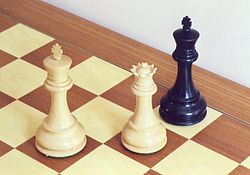
The following outline is provided as an overview of and topical guide to chess:
Contents
- Descriptions of chess
- Chess equipment
- Essential equipment
- Specialized equipment
- Rules of chess
- Moves
- Piece-specific moves
- End of the game
- Competition rules and other features
- Minor variants
- Gameplay
- General situations
- Pawn structure
- Chess tactics
- Chess strategy
- Venues (who and where to play)
- Competitive chess
- Computer chess
- History of chess
- Notable games
- Timeline
- World Chess Championship
- Science of chess
- Psychology and chess
- Chess programming
- Chess theory
- Chess in culture
- Chess media
- Chess essays
- Chess video games
- Chess websites
- Chess in popular media
- Chess organizations
- Chess players
- Top chess players
- Lists of chess players
- Chess variants
- Variants with a different starting position
- Variants with different forces
- Variants with a different board
- Variants with unusual rules
- Variants with incomplete information and elements of chance
- Multimove variants
- Multiplayer variants
- Variants with unusual pieces
- Games inspired by chess
- Historical variants
- Xiangqi and variants
- Shogi and variants
- Other national variants
- Chess combined with other sports and pastimes
- Chess variants software
- Fictional variants
- See also
- References
- External links
Chess is a two-player strategy board game played on a chessboard with 32 pieces.


